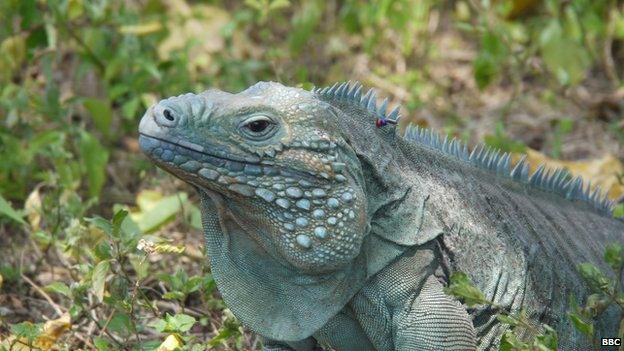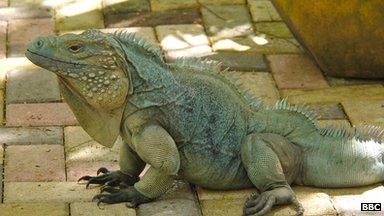Triumph of the blues - iconic iguana saved by trade ban
- Published
- comments

The blue iguana has survived in part because of the influence of the Cites trade ban.
The idyllic Caribbean island of Grand Cayman is perhaps best known for the azure tint to the sea lapping against its white sandy shores.
But there is another famous Cayman blue - a species of large, long living lizard native to the island.
The blue iguana is the island's biggest land animal.
But size isn't everything when it comes to survival.
Back in 2002 there were just a dozen or so of these giants left.
The reason for the decline were the old reliables - the destruction of their habitat and the encroachment of humans. The species was decimated by car accidents and attacks from dogs and cats. At one point it was the most threatened iguana species on the planet.
Now though there are around 750 of the creatures, land has been set aside for them, they are being released and are successfully breeding in the wild.
To all intents and purposes, the blue iguana has been saved.
So how has this happened when so many other species such as the Golden Toad, external or the Liverpool Pigeon, external have simply disappeared over the same period?
One of the factors is a breeding programme run by the Blue Iguana Recovery Programme that protects the young lizards in their first couple of years when they are especially vulnerable.
International agreement
But another important factor according to Fred Burton who runs the programme, is the influence of an international agreement called the Convention on the International Trade in Endangered Species (Cites).
Next week negotiators from 177 countries will meet in Bangkok for the Cites conference of the parties.
In the 40 years since the agreement was signed Cites has been much criticised for its shortcomings particularly the inability to stem the trade in ivory and rhino horn.

Blue Iguanas can stretch to over 1.5 metres in size and live as long as humans.
But Fred Burton is still a big fan.
"Cites is a powerful force for good, " he said. "These blue iguana are on Appendix One (all trade is banned) and there is no ambiguity about it whatsoever.
"If someone was to grab one of these iguanas and take it out of the country they would be in violation of the Cites law here and internationally."
"That's really pretty important, even if we get to 1,000 there is no way that we can sustain a harvest for the pet trade," he added.
Fred explained that at present their captive breeding facility has razor wire and security cameras and offers solid protection.
But the problem is that as more of the creatures are successfully released into the wild there will be a growing temptation to capture and sell these iguanas as high priced exotic pets.
"We've had animal smugglers here who have been caught. There is some awareness of the issue here on the island and Cites is the legal foundation for most of that. It is very valuable."
Another factor underpinning the success of the blue iguana is that people see the sum of their economic value in the numbers of tourists who come to Grand Cayman to see the cold-blooded but warm-hearted animals.
Sadly for many other species that will be subject to discussions next week, their parts are still worth more than their sum.
Follow Matt on Twitter, external.